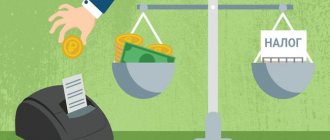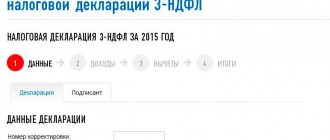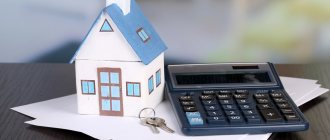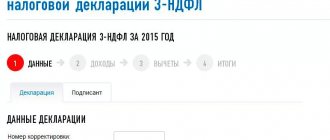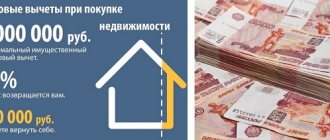28.05.2021
Parents (including adopted ones) have the right to a property tax deduction when purchasing real estate as their child's property. Adoptive parents, guardians or trustees also have the right to rely on it. This rule applies to any residential real estate: room, apartment, house or shares in them.
If you have already received a similar benefit, then you should not count on it a second time. After all, the deduction is “tied” to a specific person - the buyer. The fact that he spends money and registers an apartment in the name of another person (his child) does not matter.
There are exceptions to this rule. For example, if you did not fully use the deduction amount. In this situation, you have the right to receive it additionally. Moreover, the child retains the right to receive a property tax deduction in any case.
But before you start studying this material, we strongly advise you to read the article “What is a deduction and how is it used.” This will allow you to understand how the tax benefit mechanism itself works.
When is there a right to a deduction for a child?
First of all, find out whether you are directly entitled to the benefit. After all, as we said above, the deduction is “tied” to the one who receives it, that is, to you.
Here it is better to go from the opposite. That is, find out who does not have the right to use it. If you are not there, then you can get it for yourself, for the child, or for both yourself and the child.
So, you do not have if:
- You have already used the deduction for residential real estate purchased before 2014.
- You have already used the deduction for real estate purchased in 2014 and later, and you have completely used up its maximum amount - 2 million rubles.
- The property you purchase is paid for entirely by a third party and you have no obligation to return any money spent. For example, if the apartment is paid for by the employer. Another option is full payment from state money (budget) or maternity capital. If the apartment is purchased using borrowed funds (for example, a mortgage), this point is not about you. You have an obligation to return the money to the bank.
- The apartment was purchased from a person who is interdependent in relation to you. For example, the closest relative. The list of interdependent persons is in Article 105.1 (clause 2) of the Tax Code.
In all of the above cases, you do not have the right to a deduction. Therefore, you will not be able to get it for a child. If yours is not on this list of situations, then you have the right to count on it.
Results
So, in the article we talked about whether it is possible to receive several deductions at the same time. Yes, this can be done, but you must correctly fill out the 3-NDFL declaration and submit supporting documents to the inspectorate. You can also receive deductions from your employer at the same time. First, the individual at the inspection must receive a special tax notice for property and social deductions and submit it to the place of work. On this basis, the employer will stop withholding tax from the salary, i.e. the employee will receive more money in hand. What is the best thing to do - return personal income tax for the year at once or receive it as part of your salary - each person decides independently. Of course, in the second case, you don’t need to worry about filling out the declaration, but we took this point into account and gave examples of filing deductions in it for various life situations.
Sources:
- Tax Code of the Russian Federation
- Order of the Federal Tax Service dated August 28, 2020 No. ED-7-11/ [email protected]
- Decree of the Government of Russia No. 201 of March 19, 2001
- Decree of the Government of Russia dated 04/08/2020 No. 458
You can find more complete information on the topic in ConsultantPlus. Free trial access to the system for 2 days.
Size and conditions of receipt
The procedure for obtaining a deduction for a child is prescribed in Article 220 (clause 6) of the Tax Code. As stated in this document:
6. The right to receive property tax deductions ... have taxpayers who are parents (adoptive parents, foster parents, guardians, trustees) and who carry out new construction or purchase on the territory of the Russian Federation at their own expense of a residential house, apartment, room or share (shares) in them, ... into the property of their children under the age of 18 (wards under the age of 18, children and wards recognized by the court as incompetent). The amount of property tax deductions in the case specified in this paragraph is determined based on the actual expenses incurred taking into account the restrictions established by paragraph 3 of this article.
Conclusions.
If the apartment is completely registered for the child, then the purchase costs are considered yours. Therefore, you receive the same benefits as if you were buying real estate for yourself.
If the apartment is registered in shares with a child, then the costs of purchasing his share are also considered your expenses. Therefore, your deduction will consist of two amounts: the costs of purchasing your share and the costs of purchasing the children’s share.
The deduction is equal to the total amount of expenses for the purchase of real estate or a share in it. But the law limits its maximum size. Regardless of the cost of the apartment (share), it cannot be more than 2,000,000 rubles. per buyer.
Example: An apartment is registered as the property of the wife, husband and minor child, ⅓ each.
Situation 1 Expenses for purchasing an apartment - 7,500,000 rubles. The cost of purchasing each share is 2,500,000 rubles. (7,500,000 x ⅓).
The cost of acquiring each share (2.5 million) is greater than the maximum deduction amount (2 million). Therefore, each parent has the right to claim a deduction in its maximum amount - 2 million.
Situation 2 Expenses for purchasing an apartment - 3,600,000 rubles. The cost of purchasing each share is 1,200,000 rubles. (3,600,000 x ⅓). The costs of the child's share can be divided between the parents or transferred to only one of them.
If they are divided equally, then each parent receives a deduction in the amount of: 1,200,000 + 1,200,000: 2 = 1,800,000 rubles.
Another option is also possible. For example, the father takes on most of these expenses (800 thousand) and receives the maximum deduction, and the mother collects the remaining amount.
In such a situation, expenses and the deduction amount are distributed as follows:
- father 1,200,000 + 800,000 = 2,000,000 rub.
- mother 1,200,000 + (1,200,000 - 800,000) = 1,600,000 rub.
Who can get a child tax credit?
According to the provisions of clause 4, part 1, art. 218, paragraphs. 2-4 hours 1 tbsp. 219, paragraph 6 of Art. 220. Tax Code of the Russian Federation, personal income tax deduction for children is provided to persons who support them:
- parent;
- parent's spouse;
- the adoptive parent;
- guardian
- trustee;
- foster parent;
- spouse of the adoptive parent.
The size of the standard tax deduction for a child depends on the order of birth in a particular family. Thus, a tax deduction is provided to parents with many children for the third and each subsequent child in a larger amount than for the first and second. Separately, standard tax deductions are provided for disabled children.
You can also apply for several social and one property deductions for children. We will tell you more about deductions for children and their amounts below.
When will the tax deduction amount be reduced?
You will receive a smaller tax benefit if:
- real estate costs less than 2 million;
- part of the real estate was paid for using maternity capital. In this case, the total amount of purchase costs will be reduced by mat. capital;
- you previously used part of the deduction. In such a situation, the maximum benefit amount (2 million) will be reduced by the portion already used.
Let's look at each of these cases in more detail.
Cheap real estate
If the apartment costs less than 2 million, then the maximum deduction you can count on is equal to the cost of the property (including the cost of purchasing a child’s share).
Example: A mother and a minor son buy an apartment worth RUB 1,750,000. According to the purchase and sale agreement, shares are distributed as follows:
- mother ⅔ worth RUB 1,166,667;
- son ⅓ worth 583,333 rubles.
The amount of deduction for the mother will be: 1,166,667 (her share) + 583,333 (son’s share) = 1,750,000 rubles.
The mother is left with an underused deduction amount in the amount of: 2,000,000 (maximum amount) - 1,750,000 (declared amount) = 250,000 rubles.
She can use it when purchasing another residential property in the future.
Maternity capital or budget money
If part of the apartment was paid for using maternal capital, then the total amount of purchase costs is reduced by this amount, which can be taken into account as part of the tax benefit. A similar rule applies when purchasing real estate using public funds, for example, subsidies.
Example: A mother and a minor daughter buy an apartment worth RUB 1,890,000. into equal ownership of ½ each. Maternal capital in the amount of 450,000 rubles was used to purchase an apartment.
As a result, the amount of expenses that can be taken into account will be: 1,890,000 - 450,000 = 1,440,000 rubles.
That is, the cost of purchasing each share will be 720,000 rubles. for each (1,440,000 x ½).
The amount of deduction for the mother will be: 720,000 (her share) + 720,000 (daughter’s share) = 1,440,000 rubles.
The mother is left with an underused deduction amount in the amount of: 2,000,000 (maximum amount) - 1,440,000 (declared amount) = 560,000 rubles.
She can use it when purchasing another residential property in the future.
The deduction has already been applied
The last case. Let's assume that you have already used part of the deduction before. You are left with only an underused part of it. You can use it when purchasing other residential real estate, including the property of children.
Example A father and a minor son buy a residential building for RUB 1,350,000. into equal ownership of ½ each. That is, the cost of purchasing each share will be 675,000 rubles. (1,350,000 x ½).
Previously, the father had already received a deduction and used its amount in the amount of 850,000 rubles.
The underused amount of the father's benefit is equal to: 2,000,000 - 850,000 = 1,150,000 rubles.
The total deduction for the father’s house will be: 675,000 (his share) + 475,000 (part of the cost of purchasing the child’s share) = 1,150,000 rubles.
Receiving two social tax deductions for education and treatment at the same time
Example 3
Lvova N.T. received an income of 350,000 rubles in 2021. in StroyKomplekt LLC, from which personal income tax was withheld and paid to the budget in the amount of 43,316 rubles. subject to standard deductions. Last year, she paid for her daughter’s education in the amount of 80 thousand rubles. and expensive treatment of the spouse 540 thousand rubles, included in the list approved by Decree of the Government of Russia dated March 19, 2001 No. 201.
NOTE! SINCE 2021, a new list has been in effect, put into effect by Decree No. 458 dated 04/08/2020. When filing the 3-NDFL declaration for 2021, you need to focus on it.
In this case, there are several options for filling out the declaration, and all of them will lead to the same result.
Option 1:
In 3-NDFL, a citizen of Lvov has the right to reflect a deduction for treatment and education at the same time - it is provided to her by law. That is, she enters:
- in line 100 of Appendix 5, the amount for her daughter’s education is 50 thousand. This is the maximum she can declare;
- in line 110 of the same application - the remaining 300 thousand of her income minus the child deduction provided to her by her employer, i.e. 283,200 rubles. This amount does not cover all the costs of expensive treatment.
Option 2:
Since the amount of an individual’s income is less than the amount of expensive treatment, training expenses may not be shown in 3-NDFL. Line 110 will reflect the maximum deduction amount equal to income minus standard deductions already provided - RUB 333,200.
That is, no matter what option N.T. Lvova chooses to file the declaration, the tax office will return to her only what was transferred from her income during the year - 43,316 rubles.
Example 4
Let’s change the condition as follows: Lvova N.T. paid for her education in 2020 in the amount of 80 thousand rubles. and treatment of the husband, which is not expensive, in the amount of 540 thousand rubles. With such input data, the amount of deductions for training and treatment at the same time will be 120 thousand rubles. 3-NDFL can also be filled out in two different ways:
- fully show the expenses for your education, and indicate the expenses for your husband’s treatment in the amount of 40 thousand rubles. (120 thousand – 80 thousand);
- do not show training expenses, but fully declare a deduction for ordinary treatment in the maximum amount of 120 thousand rubles.
The inspection will return Lvova N.T. 15,600 rubles. for 2021.
Example 5
In example 3, we clarified that personal income tax was withheld from Lvova’s salary, taking into account the standard deductions provided. But what about the situation if she were not provided with them at her place of work, i.e., 45,500 rubles were withheld for a year? Is it possible for her to receive several tax deductions at the same time by filing a 3-NDFL declaration at the end of 2021?
Yes, an individual can exercise this right and claim social and standard tax deductions at the same time. You just need to fill out the declaration correctly. Filling out data on standard deductions occurs in section 1 of the same Appendix 5.
During the year, Lvova’s income did not exceed 350 thousand rubles. This means that she is entitled to a standard deduction for her daughter in the amount of 1,400 rubles for all 12 months. Total: 16,800 rub. If the employer did not provide her with these deductions, then line 070 will remain empty, and Lvova will declare the entire amount in line 080 on the declaration.
Lviv tax authorities will return 45,500 rubles.
By the way, this section is also filled out if standard deductions are received from the employer, but then line 070 would have the figure 16800.
Transferring benefits to the future
Of course, you know that the amount of the benefit reduces the income you received in the calendar year. If the income is less than the benefit, then its balance is carried over to the next and all subsequent years until it is fully used.
Depending on the size of your annual income, the procedure for obtaining a deduction may take several years.
Example In 2021, you bought an apartment together with a minor child for RUB 3,850,000. You have the right to a deduction in the amount of 2,000,000 rubles. (this is its maximum size). Your income was:
- for 2021 - 530,000 rubles;
- for 2021 - 650,000 rubles;
- for 2022 - 850,000 rubles.
You have the right to receive a deduction in the amount of:
- 2020 - 530,000 rub. The balance carried over to 2021 is RUB 1,470,000. (2,000,000 - 530,000);
- 2021 - 650,000 rubles. The balance carried over to 2022 is RUB 820,000. (1,470,000 - 650,000);
- 2022 - 820,000 rubles. From this year there will be no carryover balance. The deduction was received in full in the amount of 2 million.
At this level of income, the deduction will apply from 2021 to 2022, that is, 3 years.
Grounds for granting a deduction
Reasons for receiving the standard child tax credit:
- presence in the family of a child under 18 years of age;
- the presence in the family of a child who is a full-time student, graduate student, resident, intern, student under the age of 24 years.
Children are also entitled to several social deductions in accordance with paragraphs. 2-4 hours 1 tbsp. 219 of the Tax Code of the Russian Federation. Parents have the right:
- apply for a tax deduction for the education of a child under 24 years of age at a college, university, for additional education, clubs and sections;
- receive a tax deduction for the treatment of a child under 18 years of age;
- take advantage of a deduction for pension contributions to a non-state pension fund in favor of a child, for his voluntary pension insurance and for his voluntary life insurance for a period of at least 5 years.
In addition, parents can apply for a property deduction when purchasing an apartment for a minor child (Part 6, Article 220 of the Tax Code of the Russian Federation).
What documents are needed to deduct the child’s share?
To receive a deduction, you need to collect a certain package of documents. Their composition depends on what kind of property was purchased. There are 2 options:
- finished apartment on the secondary market under a purchase and sale agreement (SPA);
- new building under an equity participation in construction agreement (DDU).
In addition, it is important how you receive the benefit. There are also 2 options here:
- at the end of the year at the tax office at your place of residence. In this situation, you will be refunded the overpaid tax;
- in the company where you work. In this case, income taxes will no longer be withheld from you.
In both cases, you need to collect an approximately identical package of documents.
Buying a share on the secondary market
The package will include:
- real estate purchase and sale agreement (RPA);
- an extract from the state register of real estate, which confirms the transfer of ownership from the seller to you and the child;
- payment documents for payment for real estate (seller's receipt when paying in cash or payment order when paying by bank transfer);
- child’s birth certificate (when purchasing real estate or a share in it for your own child);
- decision of a guardianship or court to establish guardianship and trusteeship (when purchasing real estate for wards).
Purchasing a share in real estate under construction
The package must include:
- agreement of shared participation in construction (DDU);
- act of acceptance and transfer of an apartment completed construction;
- payment documents for payment for a new building (receipt order when paying in cash or payment order when paying through a bank);
- child’s birth certificate (when purchasing a new building or a share in it for your own child);
- decision of a guardianship or court to establish guardianship and trusteeship (when purchasing real estate for wards).
Types of personal income tax deductions
A deduction is the amount by which the tax base is allowed to be reduced for tax purposes. The Tax Code provides for several types of personal income tax deductions:
- standard;
- social;
- investment;
- property;
- tax deductions when carrying forward losses from transactions with securities and transactions with financial instruments of futures transactions traded on the organized market;
- professional.
With one deduction, everything seems to be clear: if a person has a child, he can write a statement to the employer. If you purchased an apartment, you can wait until the end of the year and return the personal income tax from the purchase (or part of it) through the Federal Tax Service, or receive a deduction at your place of work during the year.
What to do if a person has purchased an apartment within a year and paid for his child’s education at the institute. Is it possible to receive two tax deductions at the same time? Yes, you can. The most important thing is that a person has a basis for receiving deductions.
However, there are several nuances when providing deductions:
- The employer has the right to provide some deductions, and you can contact the tax authorities for them. Some can be obtained exclusively through the inspection, having previously filled out the 3-NDFL declaration and collected a package of documents.
- Some deductions can be carried forward to subsequent years, others cannot.
- Most deductions have limits.
Taking into account all the listed nuances, how can you claim several tax deductions at the same time? Let's find out further.
Property deduction
Property deduction may be associated with the purchase of property and its sale. In the second case, the deduction is either the purchase price of the property or a fixed amount (1 million rubles for housing, 250 thousand rubles for other property). This deduction cannot exceed the sale price of the assets. Therefore, the deduction is provided within the year in which the transaction was made.
How to draw up 3-NDFL when selling an apartment? What sheets need to be completed? Where can I get the numbers to fill in? All these questions were answered by experts from the ConsultantPlus legal reference system in the situation “How to fill out the 3-NDFL declaration when selling real estate (apartment).” Use trial access to view the material. It's free.
Another thing is the deduction for the purchase of housing with a limit of 2 million rubles. An individual can return up to 260 thousand rubles. You can choose a deduction until you fully use it—one year, two years, or ten years, if necessary. This is the type of deduction that is allowed to be carried forward to subsequent periods.
Property deduction can be issued at the place of work. Then the employer will simply stop withholding tax. Or you can contact the tax office for it. Then funds in the amount of personal income tax from the purchase price, but within the amount paid for the year, will be returned to the taxpayer after checking the declaration and supporting documents. If the personal income tax paid for the year does not cover the amount spent on the purchase of housing, then the return procedure can be repeated in subsequent years.
Basically, all options for choosing deductions when drawing up 3-NDFL or registering at the place of work are based on the existence of the right to a property deduction associated with the purchase of housing. After all, other types can be used only in the year in which they are due, such as standard ones, or in the year when certain expenses were incurred, such as social ones.
Social deduction
Social deduction is a reduction in the personal income tax tax base by the amount of expenses:
- expenses incurred for treatment and education of yourself and close relatives;
- spent on charity;
- contributed under voluntary insurance contracts;
- related to the funded part of the pension.
Social deductions are limited to 120 thousand rubles. Moreover, they are taken into account in the total amount, and not each separately.
The following deductions stand out:
- for the education of children - there is a limit of 50 thousand rubles. taken into account separately from other social deductions;
- for expensive treatment - they reduce the base to 0 without restrictions.
Investment deduction
The investment deduction is not yet so popular among our fellow citizens. It consists of returning the amount of money deposited into an individual investment account. It has a limit of 400 thousand rubles. You can apply for an investment deduction only through the tax office; it is not provided at your place of work.
Next, we’ll look at the most common options for getting 2 tax deductions at the same time.
How to get a deduction from the inspection
At the end of the year when the property was purchased and registered, you need to provide the tax office at your place of residence with an income tax return 3-NDFL, which indicates the amount of the deduction. It is accompanied by copies of the documents that are included in the package (see above).
If the declaration is submitted for 2021 and earlier, an additional tax refund application will be required (for information on how to prepare and fill it out, see the link). If you are filing a return for 2021 and later, the application is not required. Its text is included directly in the declaration.
Documents can be:
- transfer to the tax office or through the MFC (in person or through a representative);
- send by post with a description of the attachment (valuable letter);
- send in electronic form - through the Unified Government Services Portal or the taxpayer’s personal account.
Registration of property and investment deductions at the same time
Example 2
Let's take A.B. Petrov's income as a condition for example 2. But let him in 2021:
- bought an apartment for 5 million rubles;
- replenished an individual investment account with 300,000 rubles.
The amount of his income again does not cover all annual expenses, and we remember that property deductions can be transferred, but investment deductions cannot. In this case, Petrov A.B. in the declaration for 2021 will fully show the investment deduction in line 210 of Appendix 5.
And he will partially claim a property deduction, but in the amount of 350 thousand rubles. (650 thousand – 300 thousand).
Thus, after receiving and checking the declaration for 2021 with the IIS deduction and property deduction issued at the same time, the tax office will return 84,500 rubles to Petrov A.B. In the following years, he will need to submit a declaration to continue to return the deduction for the apartment until the entire amount of 260 thousand rubles is selected. The total amount of tax refunded on these two grounds should be 299 thousand rubles.
If you are lazy and do not fill out Appendix 5 for 2021, then the return for the year will still be 84,500 rubles, but in general the individual will lose 13% from 300 thousand rubles, i.e. 39 thousand rubles.
How to get a deduction from your employer
At the end of the year when the property was purchased and registered, you need to submit copies of documents for the apartment to the tax office at your place of residence (see above). They are additionally accompanied by an application for receiving a special Notice of your right to a deduction.
Documents can be:
- transfer to the tax office in person or through a representative;
- send by post with a description of the attachment (valuable letter).
After you receive the Notification from the tax authorities, it must be submitted to the accounting department at your place of work.
Social and investment deduction at the same time - how to fill out a declaration
Since both social and investment deductions can only be claimed in the year in which the expenses were incurred, when filling out the declaration you need to remember the limitations:
- established for social deductions in the total amount of 120 thousand rubles. or 50 thousand for a child’s education;
- established for investment deduction in the amount of 400 thousand rubles;
- in the amount of calculated and paid tax for the year.
When making these deductions, Appendix 5 is filled out.
On the right of parents to distribute deductions for children
No one can transfer their deduction, including a child to their parents. This is not provided for by tax legislation - letter of the Ministry of Finance dated 09/07/2012 N 03-04-05/7-1090.
Parents have the right to distribute deductions for their children’s shares to themselves, thereby increasing their deductions - clause 6 of Art. 220 Tax Code of the Russian Federation. By default, deductions are distributed among owners according to the size of their shares in the property. Parents have the right to distribute in any proportion all amounts of expenses incurred for the purchase + payment of mortgage interest. Accordingly, get the maximum amounts for them. The main thing is that the child is under 18 years old at the time of purchasing the apartment.
Below I will analyze individual situations and in each I will describe how and in which documents deductions can be divided. Since it is allowed to return a maximum of 260,000 rubles, up to 2,000,000 rubles of purchase expenses can be distributed per parent.
You cannot distribute the deduction to the parent who previously received it, because he has spent his right. For example, a parent returned the maximum 260,000 rubles from another property. This means that the deduction for the child’s real estate cannot be distributed to him - clause 10 of Art. 220 of the Tax Code of the Russian Federation, Resolution of the Constitutional Court dated March 1, 2012 N 6-P and letter of the Ministry of Finance dated March 16, 2015 N 03-04-05/13747.
When distributing deductions to parents, the child does not lose his right to deduction - he can receive it for other real estate purchased by him after the age of 18 (letter of the Ministry of Finance dated September 3, 2015 N 03-04-05/50743). A child cannot count on deductions for real estate that was purchased in his name before the age of 18, even when his part was not distributed to his parents. After all, at that moment he could not bear the costs of the purchase and payment of mortgage interest; they were borne by his parents - Art. 60 RF IC, Art. 26 and Art. 28 Civil Code of the Russian Federation. It's easier to understand with the examples below.
Show examples ↓ Example No. 1: Spouses Vladimir and Marina bought an apartment in 2019 for 3,000,000 rubles. The apartment was registered as shared ownership for three people - 1/3 for each spouse and 1/3 for their minor daughter Daria. The parents distributed the deduction between all the expenses for the purchase, so they received the entire deduction amount - for themselves and for their daughter’s share. Daria will not lose her entire right to deduction - she will be able to return 13% from other purchased real estate.
Example No. 2: Spouses Alexander and Svetlana bought an apartment in 2021 for 4,000,000 rubles. The apartment was registered as shared ownership for three people - 1/3 for each spouse and the same share for the minor son Artem. Both parents received deductions from other properties, so expenses cannot be allocated to them. They have lost their right.
Artem got a job at 22 and started paying personal income tax. He still will not be able to return the personal income tax for the 1/3 share of the apartment purchased in his name in 2021. The deduction is returned for the costs of purchasing real estate. Artem, due to his age, did not bear these expenses. The expenses were borne by the parents. He has the right to return 13% from other properties he purchased.
Income and expenses in the family are considered common, therefore real estate purchased during marriage is considered the common property of both spouses, even when it is registered in the name of one of them - Art. 33 and Art. 34 RF IC, art. 256 of the Civil Code of the Russian Federation. Exception: if before the transaction a marriage contract was drawn up, according to which the spouses agreed to separate property, the second spouse will not be able to count on a refund of the deduction for the share of the first spouse, because has nothing to do with this real estate - clause 1 of Art. 42 IC RF.
According to the standard, for real estate purchased during marriage, spouses can also distribute the deduction among themselves - details. Up to 100% deduction for one spouse. You cannot distribute the deduction to the spouse who previously received it from other real estate.
Situation No. 1 - the apartment was purchased by one parent with a child
When purchasing an apartment while not married, the parent-owner can distribute deductions for the child’s share to himself, thereby increasing the amount of his deductions - clause 6 of Art. 220 of the Tax Code of the Russian Federation, letter of the Ministry of Finance dated August 20, 2013 N 03-04-05/33942.
The law does not establish how to document the distribution, so this remains at the discretion of the heads of district tax inspectorates. Most often, it is enough for a parent to indicate the entire amount of purchase expenses in a regular application for a deduction - or a sample. Also, in the 3-NDFL declaration, he must indicate code 14 - Order of the Federal Tax Service of October 3, 2018 N ММВ-7-11 / [email protected] Somewhere in addition to the above statements, they will also require a free-form application for distribution - or a sample.
If the apartment was purchased during marriage, both spouses can distribute deductions among themselves for both the child’s share and the share of the owner-spouse. For example, the first owner spouse receives a deduction for his share, and the second non-owner spouse receives a deduction for the child's share. The main thing is to calculate everything correctly. Examples to help.
Parents only need to submit a standard application for the distribution of deductions among themselves. For purchase costs - or a completed sample, for mortgage interest payments - or a completed sample. An additional application for the distribution of the child's share deduction between the parents is not required.
Show examples ↓ Example No. 1: Marina bought an apartment for 3,000,000 rubles. No mortgage, not married at the time of purchase. She registered the apartment as shared ownership for herself and her minor daughter, 1/2 each. Marina can distribute the deduction for the child’s share to herself. In the application, she needs to indicate that her expenses amounted to 3,000,000 rubles, but she will receive a maximum of 260,000 rubles. No one can receive more than this amount, neither for themselves nor for their child. Her daughter does not lose the right to deduct when purchasing other real estate after 18 years.
Example No. 2: Svetlana bought an apartment for 2,700,000 rubles. At the time of purchase I was not married. She registered the apartment as shared ownership - 2/3 for herself and 1/3 for her minor daughter. Svetlana previously received the maximum 260,00 rubles for other real estate. Under this apartment, she will not be able to return income tax either for herself or for her daughter, because she has already spent her right.
Example No. 3: Spouses Dmitry and Olga bought an apartment in 2021 for 3,800,000 rubles. The apartment was registered as shared ownership - 2/3 for Dmitry and 1/3 for two minor children. The spouses had never received a deduction before. I remind you that the maximum you can return is 260,000 rubles.
Since the property was purchased during marriage, the spouses can distribute among themselves not only the deduction for the children’s shares, but also for Dmitry’s share. The spouses indicated in the application for distribution that each had expenses of 1,900,000 rubles. As a result, they will receive 247,000 rubles each. Or Dmitry’s expenses were 2,000,000 rubles, and Olga’s were 1,800,000. Then he will receive the maximum 260,000 rubles, and she will receive 234,000.
Example No. 4: Spouses Sergey and Olga bought an apartment in 2021 with a mortgage for 5,500,000 rubles. The apartment is in shared ownership - 5/6 for Olga, 1/6 for her minor son. The spouses had not previously received deductions.
Deduction for purchase: Spouses can distribute the deduction between themselves for the child’s share and for Olga’s share. After all, the apartment was bought during marriage. In the statement they indicated this: the cost of the purchase from Sergei was 2,750,000 rubles, and the same from Olga. Each of them will receive a maximum of 260,000 rubles.
Mortgage deduction: spouses can distribute the cost of paying mortgage interest in any proportion - 50 to 50, 60 to 40. Up to 100% for the first spouse and 0% for the second.
Example No. 5: Spouses Artem and Svetlana bought an apartment in 2021 for 3,800,000 rubles. They used maternity capital of 616,000 rubles. The apartment was registered as shared ownership for three people - 2/3 for Artem and 1/3 for two minor children. Svetlana wrote a refusal to receive a share. A deduction is not issued for the amount of financial capital, so it will be calculated from the amount of 3,800,000 - 616,000 = 3,184,000 rubles.
Spouses can distribute the deduction among themselves for Artem's share and for the children's shares. The application for distribution indicated that each spouse had expenses of 159,200 rubles. As a result, each of them will return 206,960 rubles.
Example No. 6: Spouses Vladimir and Daria bought an apartment in 2021 for 4,500,000 rubles. The apartment is in shared ownership - 5/6 for Vladimir, 1/6 for his minor son.
Vladimir previously received a deduction from other real estate, but Daria did not, so it’s worth distributing the deduction to her. Since you can return a maximum of 260,000 rubles, the application for distribution indicated that Daria’s expenses amounted to 2,000,000 rubles, and Vladimir’s expenses amounted to 2,500,000. Or all 4,500,000 rubles can be indicated as expenses for Daria, but she will still return only 260 000.
Example No. 7: Spouses Vladislav and Sophia bought an apartment in 2021 for 3,300,000 rubles. The apartment is in shared ownership - 5/6 for Vladislav and 1/6 for his minor son. Before the purchase, the spouses signed a prenuptial agreement, which established a separate ownership regime for the property.
Vladislav previously received a deduction from other real estate, but Sophia did not. Since there was a prenuptial agreement, Sophia will not be able to receive a deduction for Anton’s share, but only for her son’s share. That is, she can return only 13% * (3,300,000 * 1/6) = 71,500 rubles. Therefore, in the application for distribution they indicated that her expenses amounted to 550,000 rubles, the rest from Vladislav. Or all 3,300,000 rubles can be indicated as expenses for Sophia, but she will still return only 71,500 rubles for her son’s share.
Example No. 8: Spouses Anton and Elena bought an apartment in 2013 for 2,600,000 rubles. The apartment was registered as shared ownership for two people - 1/7 for the child and 6/7 for Elena. No one had received a deduction before and only recently learned of their right.
Since the apartment was purchased before 2014, the maximum 260,000 rubles are distributed to the entire apartment, and not to each owner. Spouses can distribute the deduction among themselves equally or in a different proportion, at least entirely to one of them. Still, they can return a maximum of 260,000 rubles.
Situation No. 2 - the apartment was purchased by both parents and a child
Parents can distribute deductions for the child’s share among themselves in any proportion or in full to one of them - letter of the Ministry of Finance dated March 14, 2013 N 03-04-05/7-223.
Now, when spouses register the purchased property as shared ownership, they are required to have a prenuptial agreement or a notarized purchase and sale agreement with elements of a prenuptial agreement - Art. 256 of the Civil Code of the Russian Federation. In this situation, spouses can receive a deduction only according to the size of their shares + distribute the deduction among themselves for the child’s share. If there was no prenuptial agreement at the time of purchase (this was previously allowed), then the spouses can distribute among themselves in any proportion both the deduction for the child’s share and for their own shares. It's easier to understand with examples.
Parents submit an application for the distribution of deductions among themselves in the established form. For the costs of purchasing real estate - or a completed sample, for paying mortgage interest - or a completed sample. An additional application for the distribution of the child's deduction between the parents is not required.
Show examples ↓ Example No. 1: Spouses Alexander and Marina bought an apartment in 2020 for 3,700,000 rubles. The apartment was registered as shared ownership for three people - 1/3 for each spouse and minor son. Before the purchase, they signed a prenuptial agreement stating that the apartment was subject to the separate property regime. No one has received a deduction before.
Spouses can distribute the deduction among themselves only for the child's share. To do this, they submit a statement that Alexander’s expenses amounted to 1,850,000 rubles, and Marina’s expenses were the same. Each spouse will receive 13% * 1,850,000 = 240,500 rubles. Or Alexander’s expenses amounted to 2,000,000 rubles (he will receive the maximum 260,000), and Marina’s expenses amounted to 1,700,000 rubles (she will receive 221,000).
Example No. 2: Spouses Oleg and Svetlana bought an apartment for 2,900,000 rubles in 2021 with the help of maternity capital. The financial capital was 466,000 rubles. The apartment was registered as shared ownership for four people - 1/4 each for spouses and two minor children. Before the purchase, they signed a prenuptial agreement stating that the apartment was subject to the separate property regime. No one has ever returned a deduction before. You cannot get a deduction for the amount of financial capital; family expenses for the purchase are 13% * (2,900,000 - 466,000) = 2,434,000 rubles.
Each spouse can receive a deduction only for their share + distribute deductions for children among themselves in any proportion. For example, in the application, indicate that each spouse has expenses of 2,434,000 / 2 = 1,217,000 rubles. Then everyone will return 158,210. Or Oleg’s expenses were 2,000,000 rubles (he will return the maximum 260,000), and Svetlana’s expenses were 434,000 rubles (she will return 56,420).
Example No. 3: Spouses Vladimir and Daria bought an apartment in 2021 with a mortgage for 2,500,000 rubles. The apartment is shared ownership for three people - 1/6 for the child and 5/12 for the spouses. Before the purchase, they drew up a prenuptial agreement. None of them had received a deduction before.
Deduction for purchase: Spouses can receive a deduction for their shares + distribute the deduction for the child’s share among themselves in any proportion for both of them or for one of them. For example, in the application, indicate that each spouse has expenses of 1,250,000 rubles. Then everyone will return 162,500. Or Vladimir’s expenses are 2,000,000 rubles (he will return the maximum 260,000), and Daria’s expenses are 500,000 rubles (she will return 65,000).
Mortgage deduction: since a marriage contract has been drawn up, the spouses can distribute the cost of paying interest only according to the size of their shares + distribute the child’s share among themselves. It’s easier for them to distribute all interest costs equally.
Example No. 4: Spouses Grigory and Daria bought an apartment in 2021 for 2,600,000 rubles. We used material capital in the amount of 616,000 rubles. The apartment was registered as shared ownership for four people - 1/10 for a minor son, 1/10 for an adult daughter, 2/5 for each spouse. Before the purchase, a prenuptial agreement regarding the separation of property was drawn up. No one has ever received a deduction before. There is no deduction for the amount of financial capital, so the family’s expenses are 2,600,000 - 616,000 = 1,984,000 rubles.
The deduction for each spouse for their share will be (1,984,000 * 2/5) = 793,600 * 13% = 103,168 rubles. They can also distribute among themselves the deduction for the share of only a minor son, for whom it is (1,984,000 * 1/10) = 198,400 * 13% = 25,792 rubles. For example, equally. Then each spouse will return 103,168 + (25,792 / 2) = 116,064 rubles. They need to indicate in the application that the expenses of each spouse were (1,984,000 - 198,400) / 2 = 892,800 rubles. Of these, 198,400 is the cost of the adult daughter’s share, a deduction for which the spouses cannot return.
Or the spouses can distribute the entire share of the minor son to one of them. For example, on Gregory. Then he will return 103,168 for his share + 25,792 for his son’s share. Total 128,960 rubles. In the application, they need to indicate that his expenses were (1,984,000 * 2/5) + 198,400 = 992,000. Of these, (1,984,000 * 2/5) is the cost of his share, 198,400 is the cost of 1/ 10 of his minor son, which Gregory distributed to himself. And Daria’s expenses (1,984,000 * 2/5) = 793,600 rubles, i.e. the value of her share.
Example No. 5: Spouses Artem and Natalya bought an apartment in 2021 for 4,400,000 rubles. The apartment was registered as shared ownership for three people - the minor daughter 1/8 and the spouses 7/16. They did not draw up a marriage contract.
Artem previously received a deduction for other real estate, but Natalya did not. She can return a maximum of 260,000 rubles, so the application indicated that her expenses amounted to 2,000,000 rubles, and the rest went to Artem.
Example No. 6: Spouses Anton and Elena bought an apartment in 2013 for 2,600,000 rubles. The apartment was registered as shared ownership for three people - 1/7 for the child and 3/7 for the spouses. The spouses did not draw up a marriage contract, because there was no such requirement then. No one had received a deduction before and only recently learned of their right.
Since the apartment was purchased before 2014, the maximum 260,000 rubles are distributed to the entire apartment, and not to each owner. Spouses can distribute the deduction equally or in a different proportion, at least entirely to one of them. Still, they can return a maximum of 260,000 rubles.
Example No. 7: Spouses Dmitry and Olga bought an apartment in 2021 for 4,200,000 rubles. The apartment was registered as shared ownership for four people - 1/4 each for spouses and two minor children. The spouses did not draw up a marriage contract, because there was no such requirement then.
Dmitry previously received a deduction from other real estate, but Olga did not. In this situation, she can return the maximum 260,000 rubles, i.e. deduction for your share and for the shares of your children. In the statement, the spouses indicated that Olga’s expenses for the purchase were 2,000,000 rubles, Dmitry’s were 2,200,000. In principle, they can indicate that Olga’s expenses were all 4,200,000 rubles. It does not change anything. She will still receive only 260,000 rubles.
